Thirteen students from our Early College Academy earned their high school diplomas last Friday. We are extremely proud of these youth, and so very thankful for the hard work they have done for themselves and their community.#TeachCULTURE
 DeVonntae Amundson, Dry Creek Band of Pomo Indians, graduated high school in June 2018. This fall he’s headed to college to study natural resources. Photo Twitter
DeVonntae Amundson, Dry Creek Band of Pomo Indians, graduated high school in June 2018. This fall he’s headed to college to study natural resources. Photo Twitter
Except he’s not.
When he started ninth grade, Amundson was homeless, and adrift. But he had the good fortune to live in Portland, Oregon, and could attend the Native American Youth and Family Center (NAYA) Early College Academy. His dedication to school earned him a scholarship to pay part of his college expenses.
“He’s a determined young man,” says Paul Lumley, Yakama Nation, NAYA’s executive director. “His life has completely turned around from a life of homelessness. He’s just happy.”
NAYA’s Early College Academy would not exist without the grants that support it. Nor would the college scholarship Amundson received, nor the wraparound services NAYA provides to the families of the youth they serve.
“We rely on foundation support for our youth and culture programs, alternative high school, Native-centric curriculum, early college academy, foster care, gang intervention and prevention,” Lumley said. “It’s not always easy.”
A new report: Growing Inequity: Large Foundation Giving to Native American Organizations and Causes released by the First Nations Development Institute (First Nations), says that grants $10,000 and up to Native-led organizations – an amount used as a proxy for all grants – declined significantly from 2006 to 2014.

Annual giving by large foundations to Native causes declined by 29 percent, a $35 million drop, Michael Roberts (Tlingit), President and CEO of First Nations said. Large grants have dropped by $4.3 million every year since 2006. That’s had a significant impact in Indian country.
“The programs that foundations fund hasn’t changed, but the grants are smaller,” Roberts said. “There’s fewer multi-year grants, so Native non-profits can’t predict what’s going to happen the next year or even what they can provide right now.”
Roberts said when organizations can only rely on single-year grants the costs of fundraising goes up. “The volatility and single year grants has all kinds of effects, like the costs of additional fundraising, and hiring and retaining employees unsure of a position for more than a year.”
Grants support Native youth, families and elders in projects that include education, housing, health, traditional foods and health, cultural heritage, tribal institutions, and asset building. The loss of grant funding can have a very real and detrimental effect in Indian country.
Forty percent of our student body are homeless,” Lumley said. “Portland Public Schools sends the kids to NAYA when they’ve given up on them. Most if not all are credit-deficient, so it means they’re not going to graduate on time.”
Yet 40 percent did graduate on time this year. The year before, 74 percent graduated on time.
“What we’re doing works,” Lumley says. Still, there are worries. One of their primary funders started limiting their funding to one program at a time. “If they’re funding housing they won’t fund education,” he said.
Tribal nations, especially those with gaming operations, are making up some of the deficit.
“The tribes who have done well are highly philanthropic,” Roberts says. “We’ve did a brief on the tribes in Oregon. Tribes are doing a lot not only in their area but inter-tribal. They are great corporate citizens.”
The largest contributor to Native American tribes and causes is the Shakopee Mdewakanton Sioux Community (SMSC) in Minnesota. Last year, the Shakopee Tribe awarded nearly $3 million in grants to tribes and Native causes across the country.
“The Dakota people have a long-standing tradition of ‘wo’okiye,’ or helpfulness, and one of the ways the Shakopee honors that tradition is through philanthropy,” SMSC chairman Charles Vig said in a statement.
Roberts said increasingly, tribes are the economic engines of their region. He pointed to the Kalispel Tribe in northeastern Washington. They are building a grocery store that will feature fresh fruits and vegetables, meats and staples for healthy meals, a deli and free internet that will serve the local community, who must drive 25 minutes to reach the closest large store.
“The Kalispel gave $1.8 million in grants to the local fire and rescue,“ Roberts said. “There are only 448 tribal members. They built a regional health center. You see this again, and again.
“I say it’s high time for the rest of the country to reciprocate.”
For over 25 years, First Nations has given more than $29.8 million to Native American projects and organizations. Roberts said they saw a correlation between the decrease in foundation giving and an increase in their grant applications.
One non-Native organization that has stepped up is the Northwest Area Foundation. Their philanthropy began with the original owners of the Great Northern Railway in the eight states the railroad serviced, who believed, “The wealth of our region is rooted in Native lands and communities—and we’re committed to acknowledging and honoring that history.”
Their organization devote 40 percent of their grant dollars to Native-led organizations that advance economic, social and cultural prosperity in the urban, suburban and reservation communities that anchor their region.
They’ve invested over $28 million in Native-led organizations between 2012-2016, and currently have grants out to 56 Native-led organizations.
“We wanted to continue and increase that commitment, recognizing we share a footprint with 75 Native nations,” program director Karla Miller said in an email.
The report doesn’t discount the many non-Native organizations who have continued to support Indian country. As the report emphasizes, their giving pays off.
“DeVonntae just gave an amazing speech at our luncheon fundraiser,” Lumley said. “He got a standing ovation from 300 people. I think it’s really great that we can save these kids and turn their lives around.”